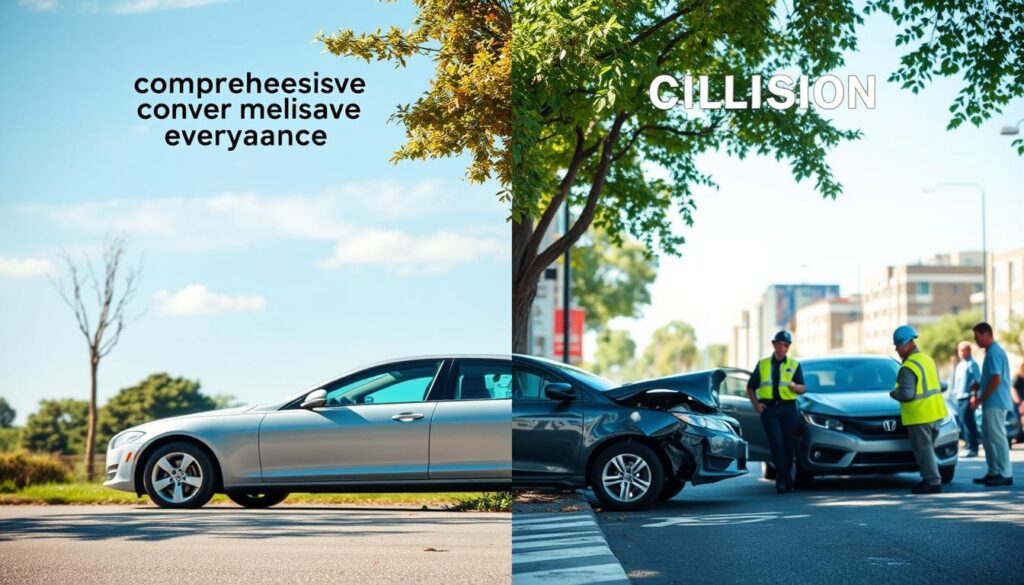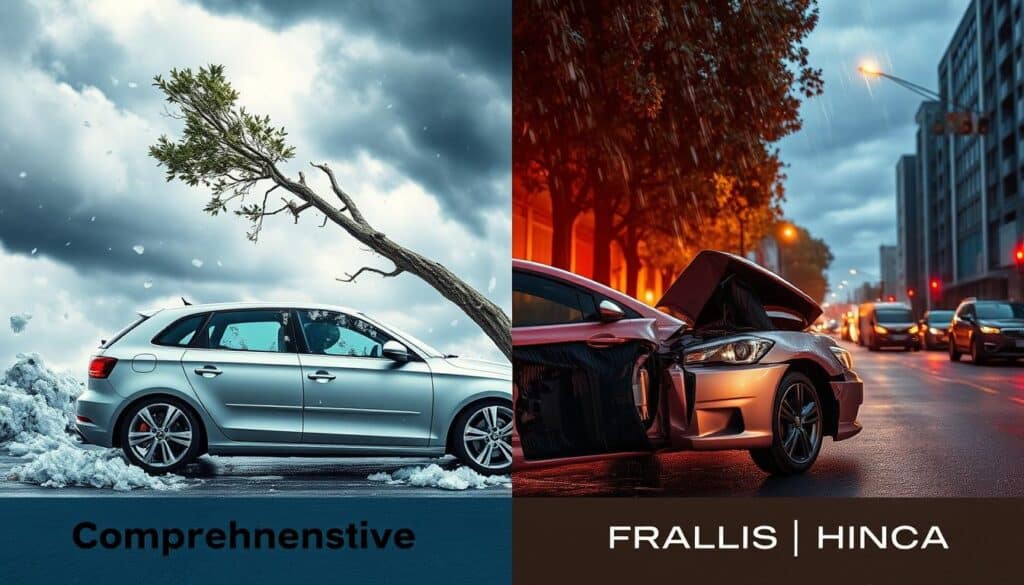When you’re looking at auto insurance, you’ll have to decide between comprehensive and collision coverage. These are key parts of a ‘full coverage’ policy that can protect your car. But knowing the difference between them is important to get the right protection. For a complete guide on auto insurance and how to get the best quotes, check out our Auto Insurance Quotes Guide. In this article, we’ll cover four key points to help you make a smart choice about your car insurance.

Key Takeaways
- Comprehensive coverage protects against non-collision incidents like theft, vandalism, and natural disasters, while collision coverage protects against crashes with other vehicles or objects.
- The cost of comprehensive and collision coverage can vary based on factors like the insurer, your location, and the value of your vehicle.
- Adjusting deductibles can help you manage the cost of your comprehensive and collision coverage. Higher deductibles generally lead to lower premiums.
- Selecting the same deductible amount for both coverages can help you predict your out-of-pocket costs in case of vehicle damage.
- Comprehensive and collision coverage may be required if you lease or finance your vehicle, even though they are not mandated by law.
Understanding Collision Coverage
Collision coverage is a key part of your auto insurance. It covers repairs or replacement if your car hits another, a stationary object, or rolls over.
What It Covers
Collision coverage pays for repairs up to your car’s actual cash value, minus your deductible. So, if your car gets damaged in an accident, your insurer will cover the costs. This is subject to your policy limits and deductible.
When You Need It
If you lease or finance your car, you might need both comprehensive and collision coverage. Even if it’s not required, it’s wise for valuable cars. It helps avoid the cost of repairs or replacement after an accident.
Drivers in risky areas or with expensive cars should get both comprehensive and collision coverage. Places with lots of damage from fallen branches or animals might also need comprehensive auto insurance.
Collision insurance can also help with repairs, even if the other driver is uninsured.
Choosing to buy collision and comprehensive coverage depends on your car’s value and the risk of accidents. If your car is totaled, the repair costs must be over 75% of its value plus salvage value. If you keep a totaled car, the salvage value will be subtracted from the settlement.
Claims frequency and severity can also impact insurance rates, like in California with “shared fault” laws.
“Collision insurance can help pay for vehicle repairs even if the other driver involved in the accident is uninsured.”
Understanding collision coverage helps you choose the right auto insurance for your needs and budget.
Comprehensive vs Collision Coverage
Auto insurance has two key types: comprehensive and collision coverage. Comprehensive covers damage not from accidents, like theft or fire. Collision coverage, however, deals with damage from accidents.
Comprehensive and collision coverage differ in what they cover. Comprehensive is for non-accident damage, while collision is for accident damage. While comprehensive is not required by law, lenders might ask for it for financed or leased cars. Whether to get comprehensive depends on your car’s value, your needs, and your budget.
| Coverage Type | Average Annual Cost | Examples of Covered Incidents |
|---|---|---|
| Comprehensive | $134 | Theft, vandalism, natural disasters, hitting an animal |
| Collision | $290 | Collision with another vehicle or object |
The cost of these coverages can change based on where you live and how you drive. For example, in New Jersey, comprehensive costs about $130, while collision can be up to $422. Picking higher deductibles can cut your premium by 15% to 30%.
Choosing between comprehensive, collision, or both depends on your car’s value, how you drive, and your money situation. By understanding each type, you can pick the right insurance for you.

Remember, comprehensive and collision insurance are not the same as full coverage. Full coverage includes state minimums plus these extra coverages. Knowing the details of auto insurance helps you make a smart choice and stay safe on the road.
Choosing the Right Deductibles
Choosing the right deductible for your auto insurance is key. It affects how much you pay each month or year. A higher deductible means lower premiums, but you’ll pay more out-of-pocket for claims. Make sure you can afford the deductible if you need to make a claim.
Impact on Premiums
Your deductible choices can change your insurance costs a lot. In 2020, the average collision premium in the U.S. was $370.73. California drivers paid the most, at $501.64, while Wisconsin paid the least, at $244.82. Comprehensive insurance costs averaged $174.26 in 2020, with California paying the least and South Dakota the most.
Balancing Costs and Coverage
Finding the right deductible balance is important. A lower deductible means higher premiums but less out-of-pocket cost for claims. A higher deductible lowers premiums but means you pay more for repairs. Think about your budget and how much risk you’re willing to take when picking deductibles.
Some states have rules for deductibles, like New York’s $50 for comprehensive and $100 for collision. Insurance companies also vary in their deductible policies. They might change your rates or drop your coverage if you file too many claims.

Factors Affecting Comprehensive and Collision Rates
Auto insurance rates are influenced by comprehensive coverage and collision coverage. Insurers look at many risk factors to set these rates. Your vehicle’s value and driving history are big factors in what you pay.
The value of your vehicle is a big deal. More expensive cars mean higher comprehensive and collision rates. This is because fixing or replacing them costs more. Also, a car’s physical damage rating affects its insurability and rates.
Your driving record matters too. If you’ve had accidents or claims, you’ll likely pay more. This is because your driving history shows you might have more claims in the future.
Where you live and how old you are also play a part. Areas with high crime or natural disaster risks have higher comprehensive costs. Young drivers, who are more likely to be in accidents, pay more for collision coverage.
Comprehensive coverage is usually cheaper than collision coverage. This is because comprehensive covers more, like theft and natural disasters, which cost less to fix than accidents.
Knowing these factors helps you choose the right auto insurance. You can find a good balance of coverage and cost for your needs.
Conclusion
Comprehensive and collision coverage are key parts of a full-coverage auto insurance policy. They offer strong protection for your vehicle in many situations. Knowing the differences between these coverages helps you choose the right one for your needs and budget.
When buying a new policy or checking your current one, think about your vehicle’s value and your driving habits. Also, consider your financial situation when picking deductibles and coverage levels for your comprehensive and collision insurance.
Customizing your comprehensive coverage is crucial for good protection on the road. By looking at risks, checking your vehicle’s value, and understanding policy terms, you can find the right balance. This ensures your comprehensive coverage gives you the peace of mind and financial security you need.
FAQ
What is the difference between comprehensive and collision coverage?
Collision coverage helps pay for damages when your car hits something else or a road hazard. It covers things like crashing into a fence or a building. On the other hand, comprehensive coverage protects your car from damage not caused by accidents. This includes theft, vandalism, natural disasters, and hitting animals.
When do I need collision coverage?
If you lease or finance your car, you might need to have both comprehensive and collision coverage. Even if it’s not required by law, getting collision coverage is smart if your car is worth a lot. It helps you avoid the cost of fixing or replacing your car after an accident.
What is “full coverage” car insurance?
“Full coverage” car insurance usually means you have both comprehensive and collision coverage, plus any state-mandated auto insurance. But remember, “full coverage” isn’t a real insurance term. So, always check with your lender or agent to know what you’re getting.
How do deductibles affect my comprehensive and collision premiums?
Your deductible choice can really change your insurance costs. A higher deductible means you pay more before your insurance kicks in. This usually makes your monthly or yearly premium lower.
What factors affect the cost of my comprehensive and collision coverage?
Many things influence how much you’ll pay for comprehensive and collision coverage. These include your car’s value, your driving history, your age and where you live, and your deductible choice. Cars that cost more to fix or replace, and drivers with accidents or claims, will likely pay more for these coverages.

